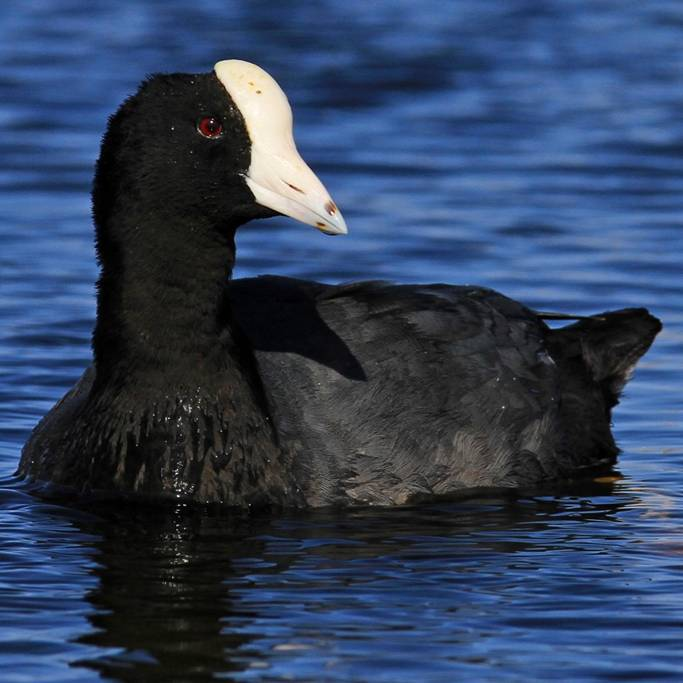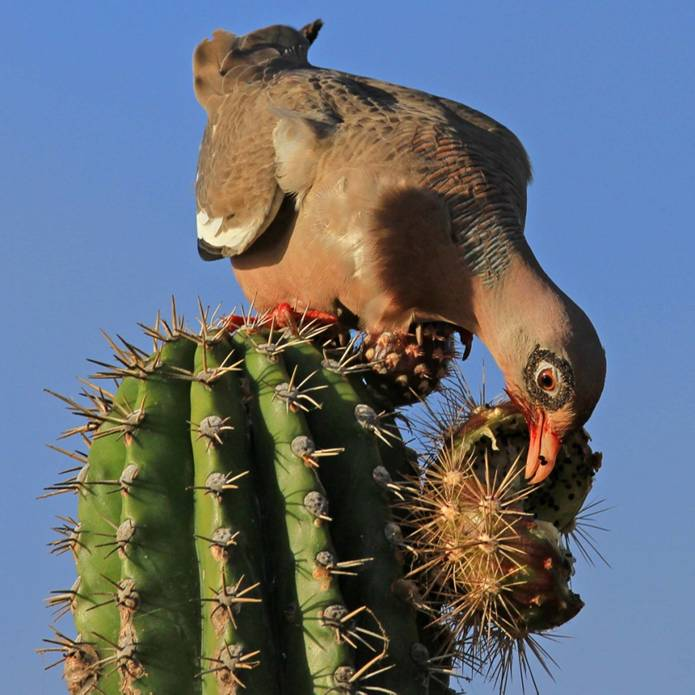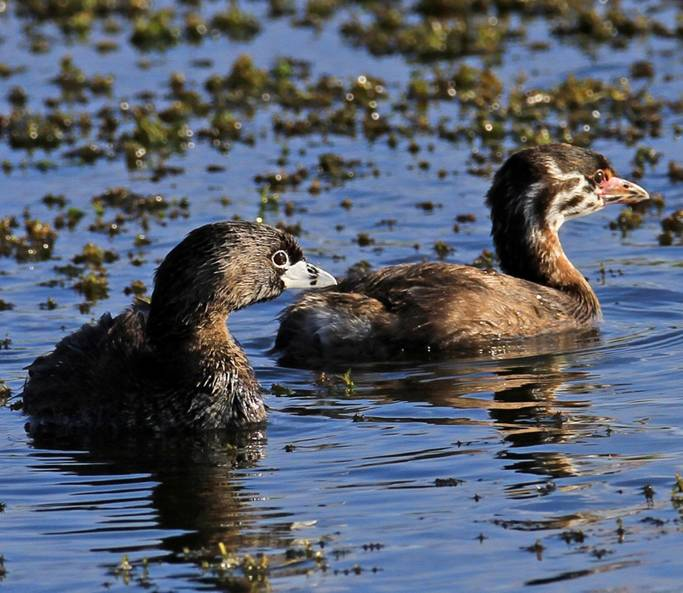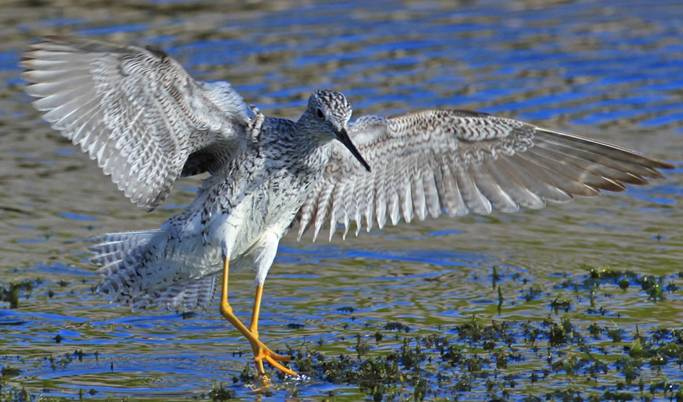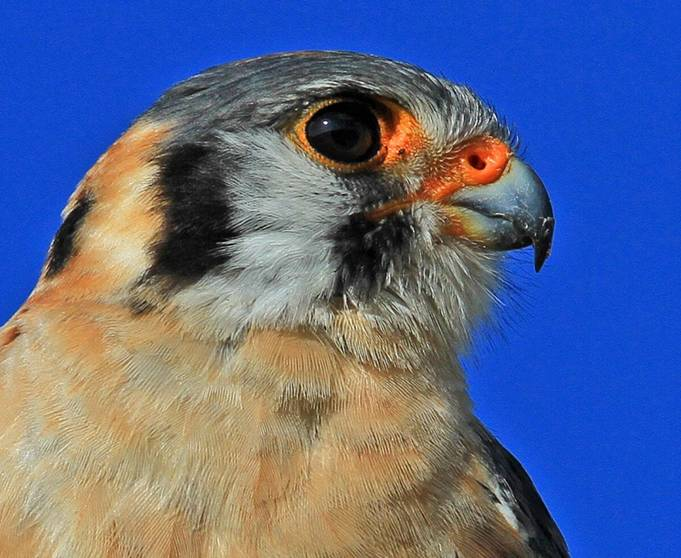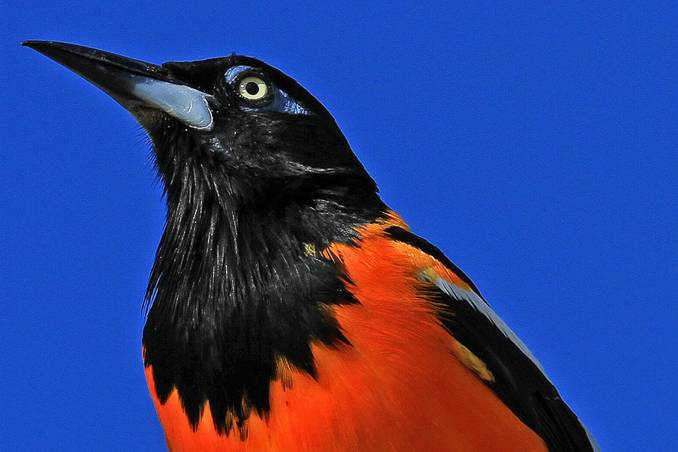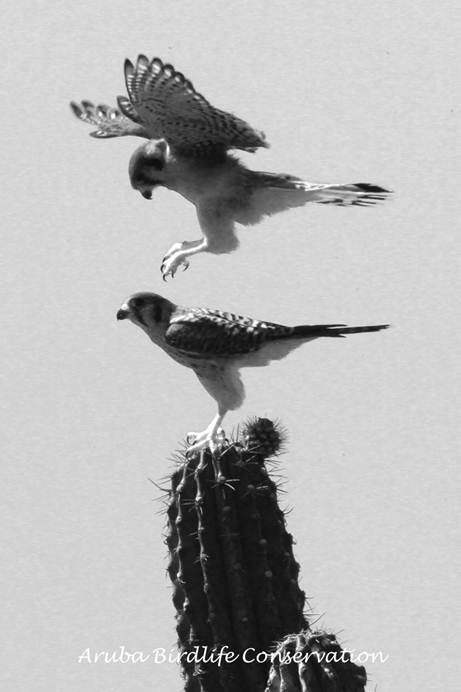|
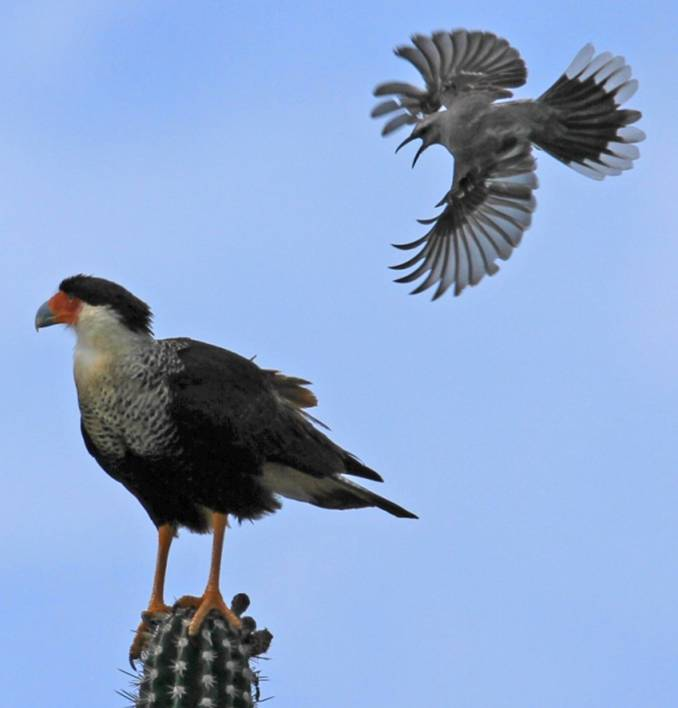
|
Chuchubi chasing away a Warawara from its nesting location.
Photo:
Greg Peterson – 17 April 2011 – Aruba
|
|
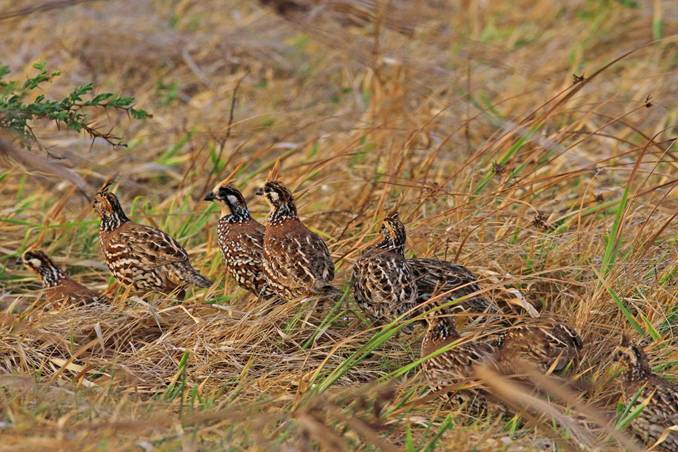
|
Photo: Greg Peterson – 24
April 2011 – Tierra del Sol - Aruba
English: Crested Bobwhite
Papiamento: Patrishi
Dutch: Kuifbobwhite
Scientific: Colinus cristatus
|
|
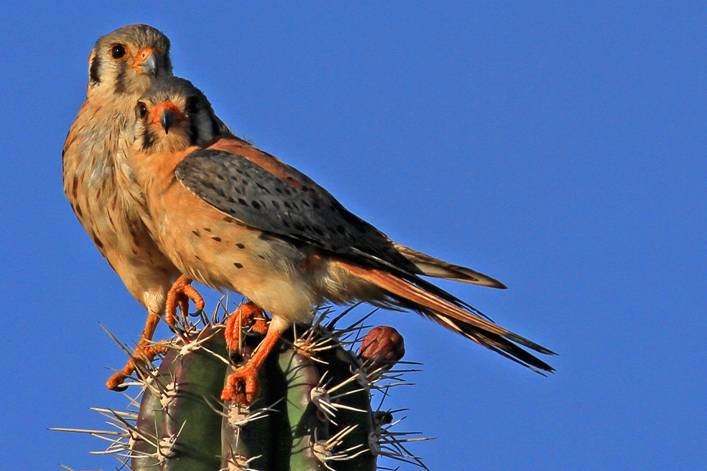
|
Photo: Greg Peterson – 25 April 2011 – Tierra del Sol
- Aruba
English: American Kestrel
Papiamento: Kinikini
Dutch: Amerikaanse Torenvalk
Scientific: Falco sparverius
|
|
TO SEE HOW YOU CAN HELP, CLICK ON THIS LINE:
Aruba Birdlife
Conservation You can help save our birds!
|
|
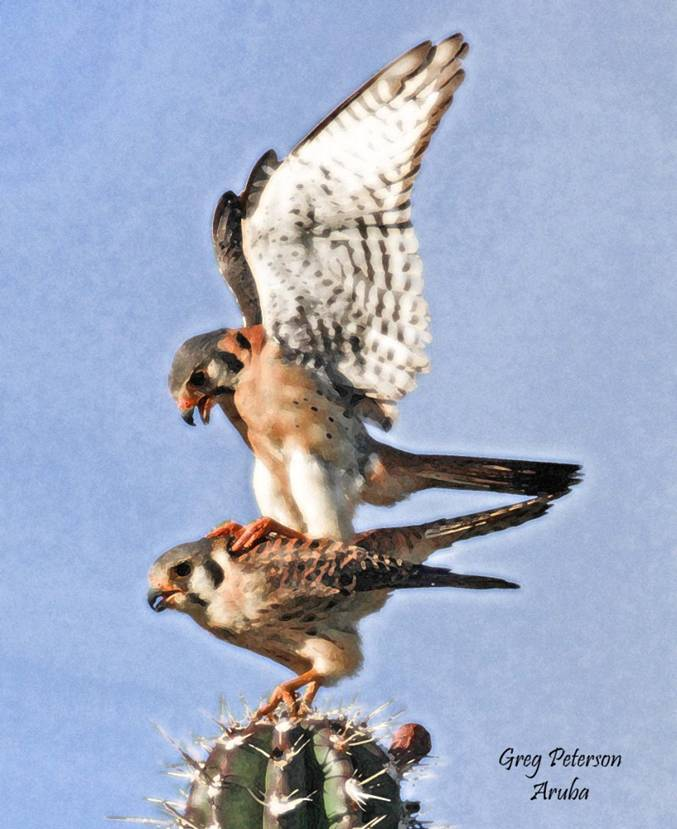
|
Artistic rendering of the act of
procreation of Aruba’s Kinikini.
Photo and rendering: Greg Peterson
– 25 April 2011 – Tierra del Sol - Aruba
English: American Kestrel
Papiamento: Kinikini
Dutch: Amerikaanse
Torenvalk
Scientific: Falco
sparverius
|
|
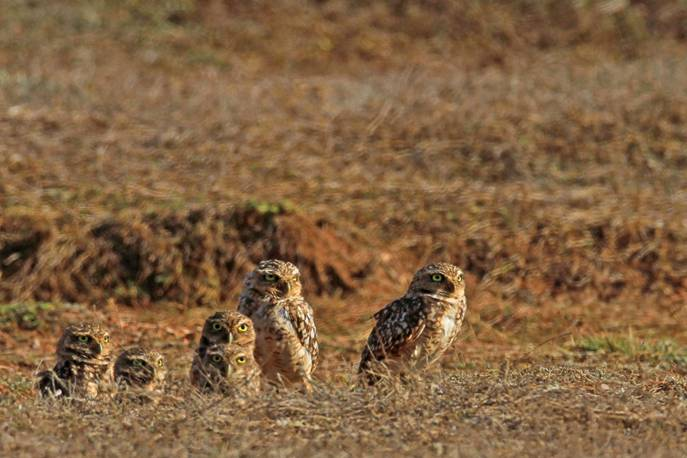
|
And then there is that sparkle of
hope again. Two proud and protective Shoco parents (Aruba’s
Burrowing Owl) with their brood of four.
Aruba Birdlife Conservation has
campaigned strongly to get this local endemic subspecies nominated
as Aruba’s National Bird. But so far nothing yet from the committee
involved in this matter. March 31st 2011 was the deadline
for their project. Minister Sevinger will be responsible for the
final decision. We keep our fingers crossed and hope that our Shoco
will soon be nominated. Nominating the Shoco as Aruba’s National
Bird might just make the difference between the Shoco making it … or
not making it.
Photo: Greg Peterson – 1 May 2011 –
Aruba (long distance shot…)
|
|
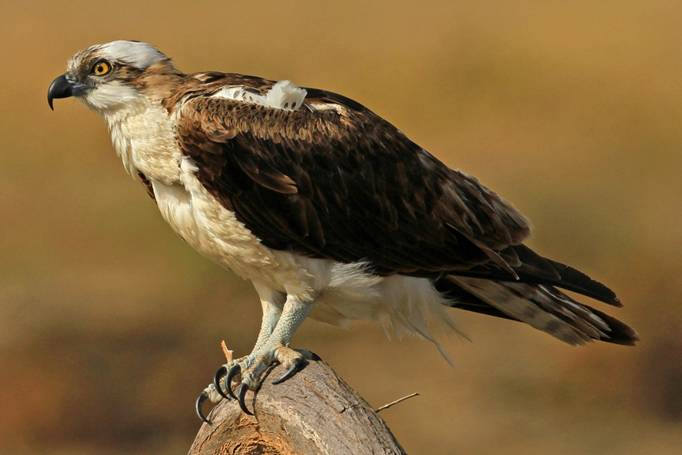
|
The Osprey eats fish.
Its eyes are like binoculars. It flies around above our waters until it
targets its prey. Then it hangs still in the air for a moment, pulls in
its wings and dives with high velocity straight at the fish. When
hitting the surface of the water its claws are stretched forward and its
wings are stretched out in the opposite direction. I have witnessed the
entire bird disappear under water only to appear shortly afterwards
holding on to its catch with its very long talons; deadly weapons. The
Osprey is then wet of course and has extra weight to lift in order to
break free from the surface of the water. The Osprey then flies to a dry
and safe location for dinner. It is not successful every time it dives.
I have seen it dive up to six times before it scored the catch of the
day. Once having its fill, the Osprey takes a moment of rest… well
deserved.
Photo: Greg Peterson – 1 May 2011 – Aruba
|
|
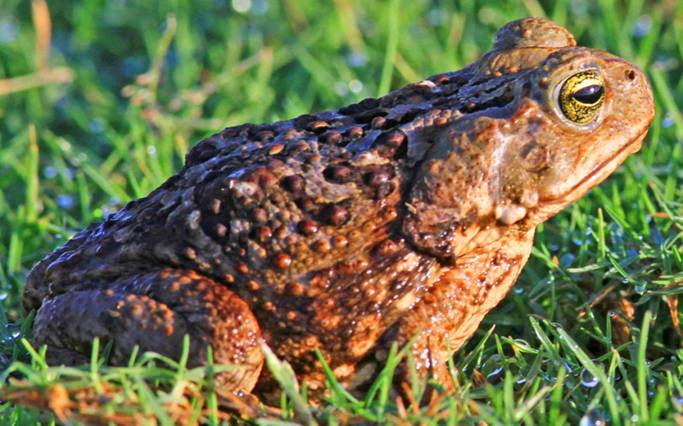
|
Another invasive species: the Sapo
(Giant Toad). First registered in Aruba in the nineties, this toad
is like the Boa constrictor, a threat for Aruba’s fauna. This toad
has glands on its back that contain a poison which can be emitted in
a foamy form. It also has glands next to its ears from which it can
squirt the poison up to a distance of 30 centimeters. Many dog
owners have lost their pets. A dogs mouth has to be washed with
water immediately once detected that it had one of these toads in
its mouth. Then rush it to the vet. This toad eats all types of
small animals, even our baby Cascabels (rattlesnakes). Be cautious
when handling one of these creatures. They can grow as large as one
of our Shoco’s (Burrowing Owls) : 20 centimeters.
Photo: Greg Peterson – 30 April
2011 – Aruba
English: Giant Toad
Papiamento: Sapo
Dutch: Reuzenpad
Scientific: Bufo marinus
|
|
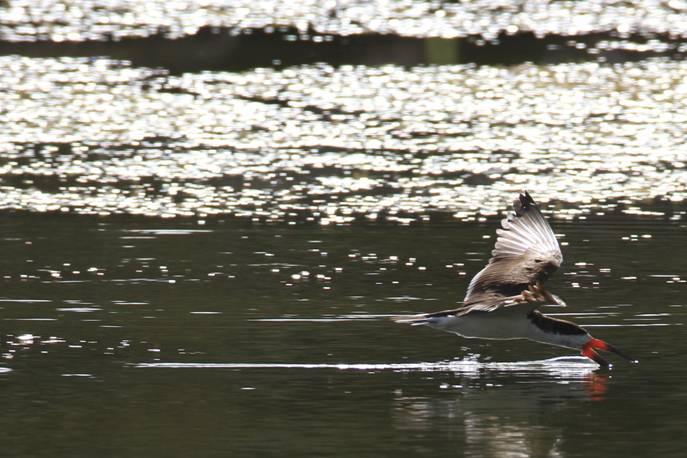
|
They are back again, our skimmers. Just two this
time. A few years back there were more than a hundred. They can fly
for a very long time, maneuvering around the wetlands at Tierra del
Sol. It will position itself just above the water surface and lower
its jaw into the water. Once it touches a fish, the beak snaps shut
delivering the catch of the day. Very elegant and peaceful fliers.
Very successful hunters. This is an early morning picture.
Photo: Greg Peterson – 30 April 2011 – Aruba
English: Black Skimmer
Papiamento: Pico di sker
Dutch: Amerikaanse Schaarbek
Scientific: Rynchops niger
|
|
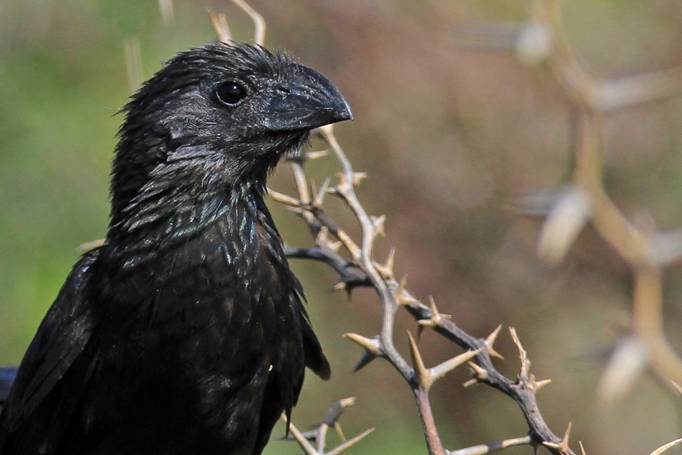
|
In Aruba we get three birds confused with each other.
If we see a black bird and it is the size of a Tropical Mockingbird
a.k.a. the ‘Chuchubi’ in Aruba, we automatically call it Chuchubi
Preto (preto meaning ‘black’). The bird depicted in this picture is
the original Chuchubi Preto or Groove-billed Ani. If you observe the
bill or beak of the bird, it has a rounded top part and there are
grooves in it as well. The other two, the Carib-Grackle (Papiamento:
Zenata caribena) and the Shiny Cowbird (Papiemento: Parha vakero
lustroso), have very different appearences, their beaks are pointed
for instance. The Shiny Cowbird is very shiny indeed, almost bluish.
The Carib Grackle’s tail, instead of it appearing horizontal as in
the case of most birds, it actually appears vertical, like the
rudder of a boat. The tail of the Chuchubi preto is relatively very
long, of the other two, they are shorter. So, not every black bird
is a Chuchubi Preto.
Photo: Greg Peterson – 30 April 2011 – Tierra del Sol
- Aruba
English: Groove-billed Ani
Papiamento: Chuchubi Preto (a.k.a. ‘Cassilia’)
Dutch: Groefsnavelani
Scientific: Crotophaga sulcirostris
|
|
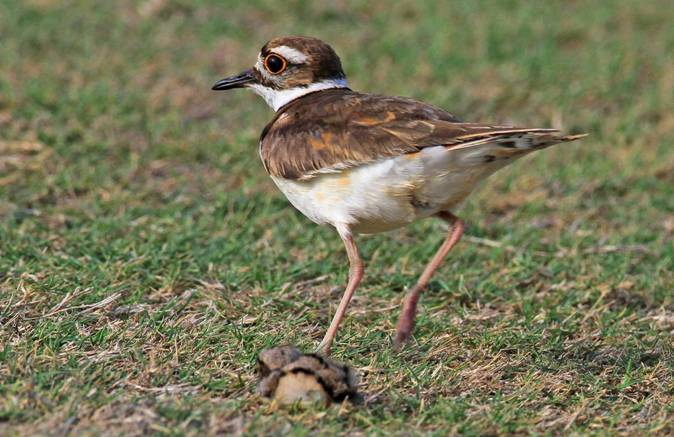
|
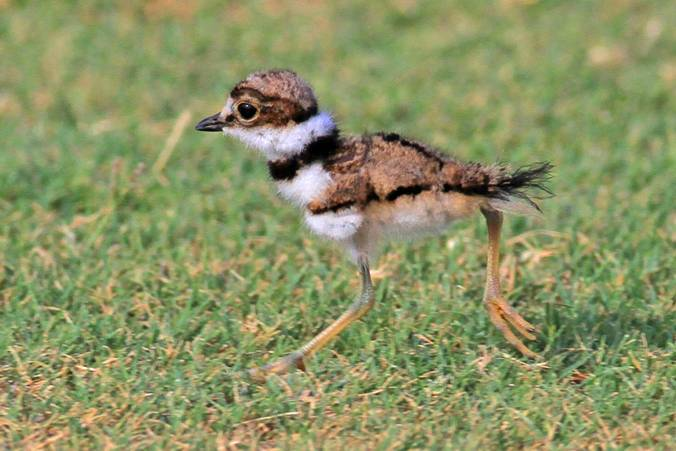
|
Tierra del Sol’s golf course is full of surprises!! I
gladly share this one with you. On the way back from the Tierra del
Sol’s salinja, on the way to the main building I passed by a ‘tee’
and noticed 4 killdeers in a squeamish with each other. I love it
when birds draw my attention. If you look a little closer to the
first picture, you’ll see something just at one of the feet of the
grown-up bird. This turned out to be a chick. The parents of this
chick were trying to chase away the other pair that entered their
breeding territory. In the following picture you can see the chick
making a run for it from the invading killdeer pair. We see a lot,
but there is so much more to see.
Photo: Greg Peterson – 29
April 2011 – Tierra del Sol - Aruba
English: Killdeer
Papiamento: Lopi killdeer
Dutch: Killdeerplevier
Scientific: Charadrius vociferus
|
|
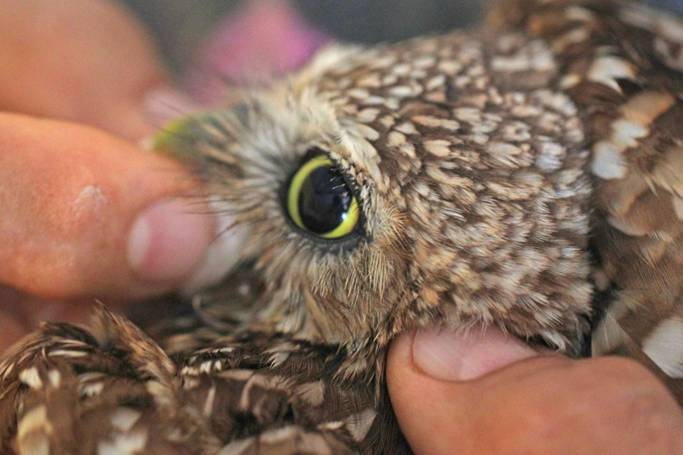
|
This baby Shoco (Burrowing Owl) was
rescued and is being given a second chance by Dr. Ricardo Gogorza.
In this picture it is being hand
fed. Just super!
Photo: Greg Peterson May 8, 2011 -
Aruba
|
|
Courtesy: Aruba Birdlife
Conservation You
can help save our birds! Click on the link.
|
|
This bird is the Nightjar. I
believe the White-tailed Nightjar. It is a nocturnal bird and is very
infrequently seen. Chances are that if you were to walk next to it over
day, you still wouldn’t see it since its camouflage is outstanding. It
catches beetles and moths during flight at night. This bird was rescued
by a girl (makes me so proud!!) and the grown-ups around her managed to
get it to Aruba’s magical bird doctor, professionally he is also a
doctor by the way. Dr. Ricardo Gogorza has a very long track record of
getting sick or wounded birds recuperated and back into nature. Such
actions really make my day. I took these pictures by Ricardo to be able
to identify this very infrequently seen bird. It is a true beauty. To
see the entire series of pictures, just scroll down. Enjoy.
Aruba Birdlife Conservation – Greg Peterson
|
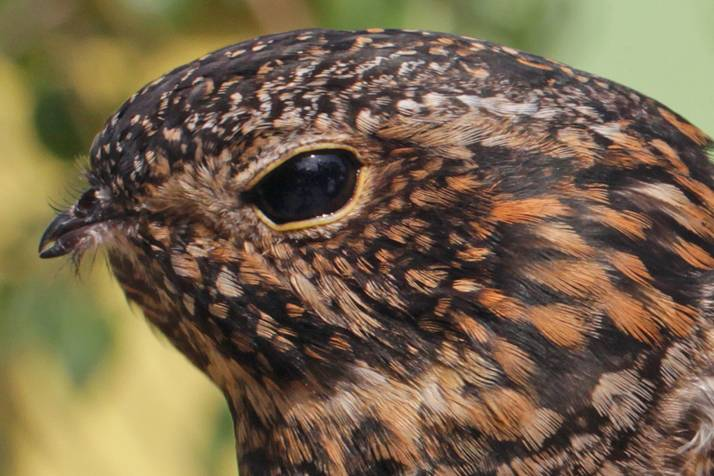
|

|
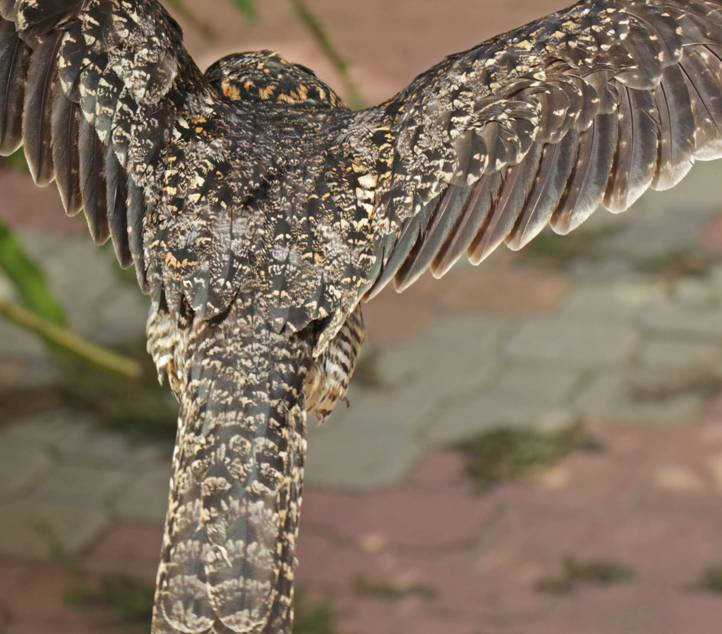
|
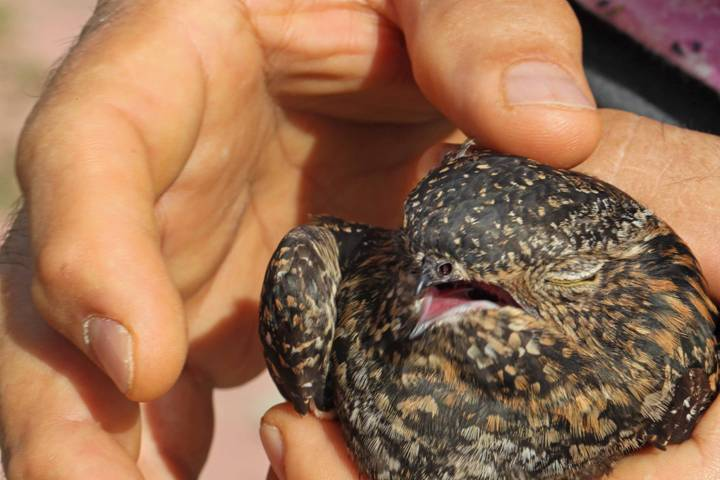
|
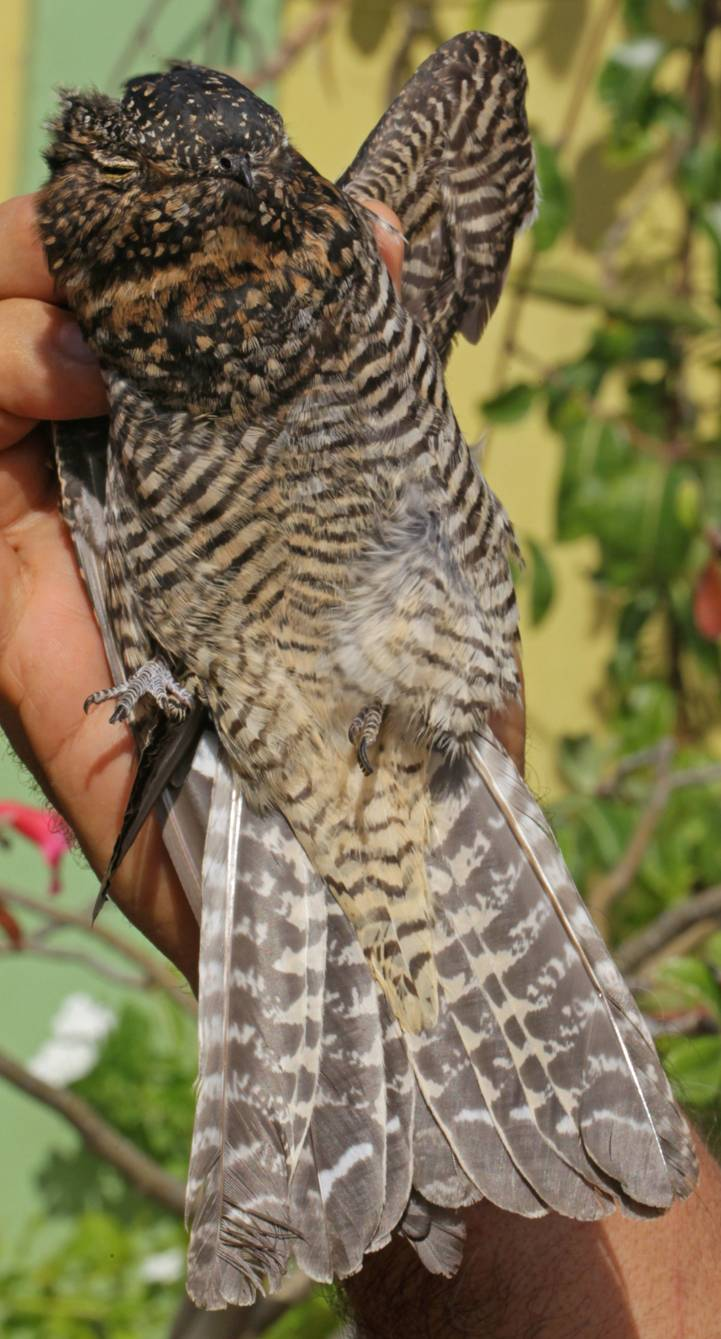
|
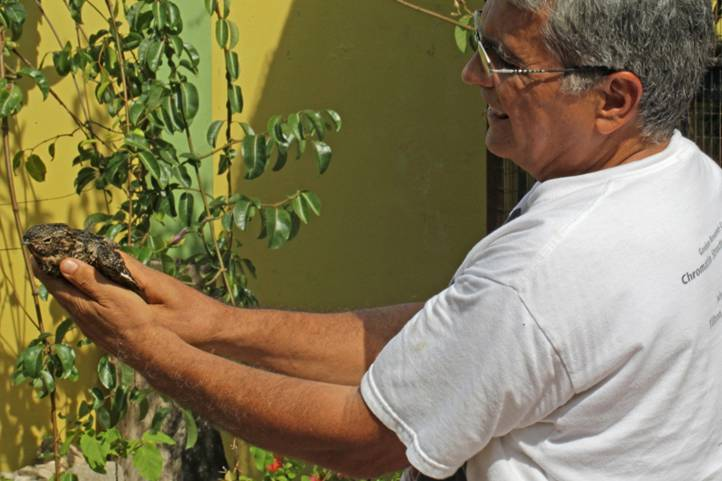
|
|
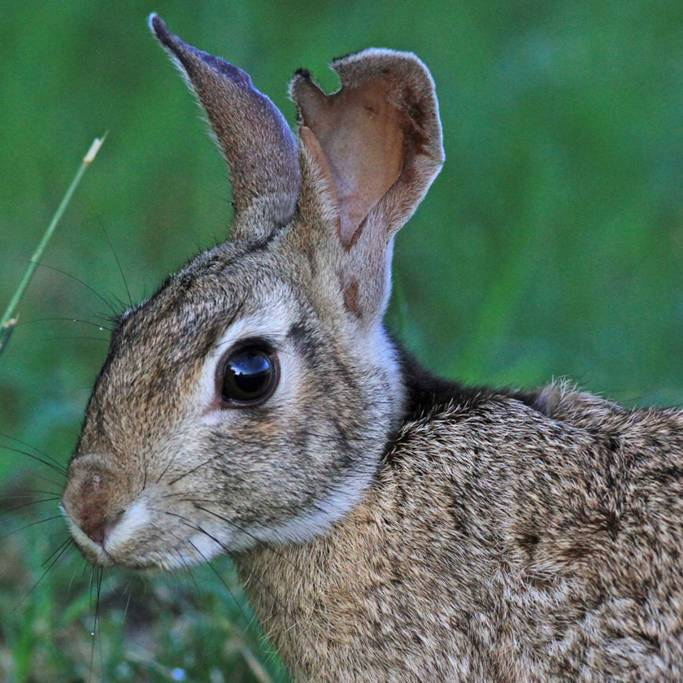
|
Aruba’s Cottontail is neither a hare nor a rabbit !!
Its fur color looks like a combination of white, grey and light
brown. But its 3rd Latin name ‘nigronuchalis’ depicts it
to be a subspecies and refers to the black stripe on the rear of its
head and back. It grows up to 35 centimeters. In years gone by it
was hunted by humans and now by Boas. Its numbers also seem to be
dwindling. This Cottontail had an unfriendly encounter if you look
at the tip of its left ear. One of Aruba’s jewels…
Photo: Greg Peterson – 8 May 2011 – Aruba
English : Cottontail
Papiamento : Konenchi - Koneo
Dutch : Konijntje
Scientific : Sylvilagus floridanus nigronuchalis
|
|
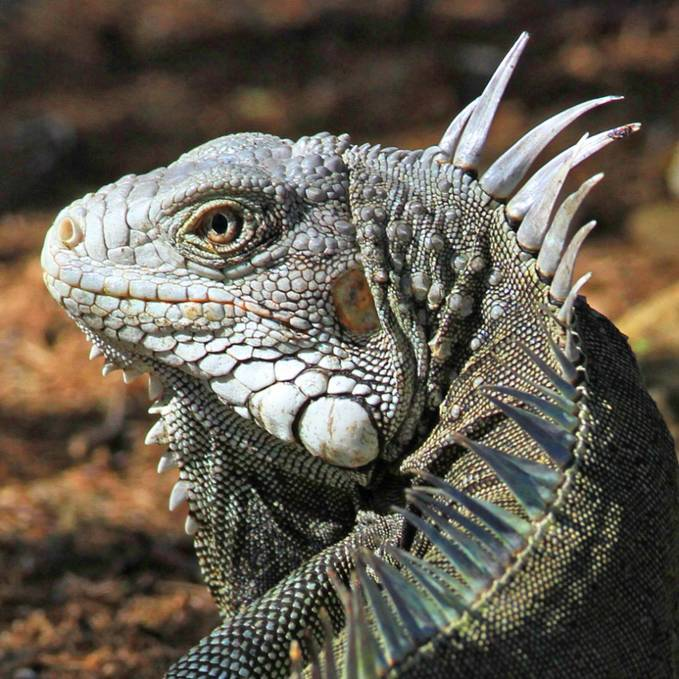
|
Fully grown, this ‘King of our Cunucu’ may –
including its tail – reach 2 meters in length. I am sure if
Spielberg would have studied this animal well, he would have filmed
part of Jurassic Park in Aruba. It is a delight for the eye when two
old machos try to trump off each other for some pretty dame in the
neighborhood. One of the actions is that they move their heads up
and down and in doing so show the opponent the skin flap hanging
from their lower jaw and throat. But if none backs off, then you can
expect a wrestling match. Sometimes they even become like Zorro and
use their natural whips on each other in the contest of domination.
In general, they are slow moving creatures, but every now and then
you might get surprised when they move into gear. One of Aruba’s
jewels.
Photo: Greg Peterson – 8 May 2011 – Aruba
English : Green Iguana
Papiamento : Yuana
Dutch : Groene Leguaan
Scientific : Iguana iguana
|
|
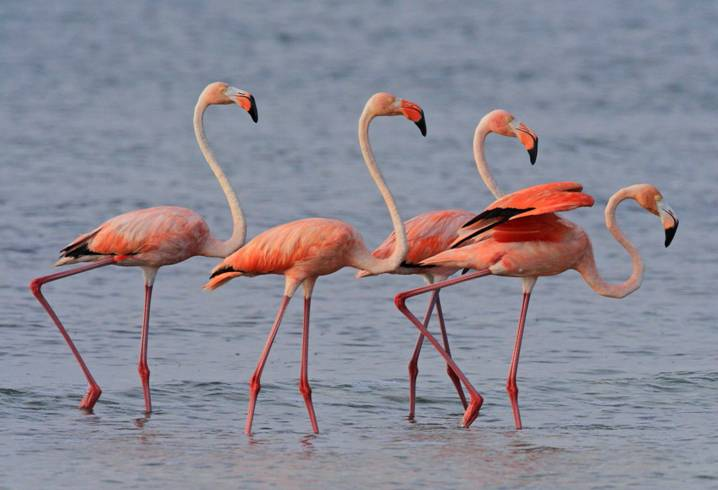
|
In May, between one to two thousand species of birds
are on the move. This is the peak of the birds’ spring migratory
season. Birds can be observed all over the world on their journeys,
quite often returning to their breeding grounds. At this moment
Aruba is being visited by a relatively small flock of Flamingoes. I
counted 9 in the flock.
The range of the Greater Flamingo is from the
Caribbean region and from Central America south to North-eastern
Brazil and the Galapagos Islands. This bird is a breeding resident
in Bonaire and a regular non-breeding visitor in rather large
numbers in Curacao.
However, in Aruba its status is classified as an
irregular non-breeding visitor in small numbers.
This is just the third time that I have seen them in
Aruba. In this picture 4 of the flock.
A very special treat for bird lovers in Aruba. A
marvelous sight!
Photo: Greg Peterson – 18
May 2011 – Aruba
English : Greater Flamingo
Papiamento :
Flamingo
Dutch :
Rode Flamingo
Scientific :
Phoenicopterus ruber’
|
|
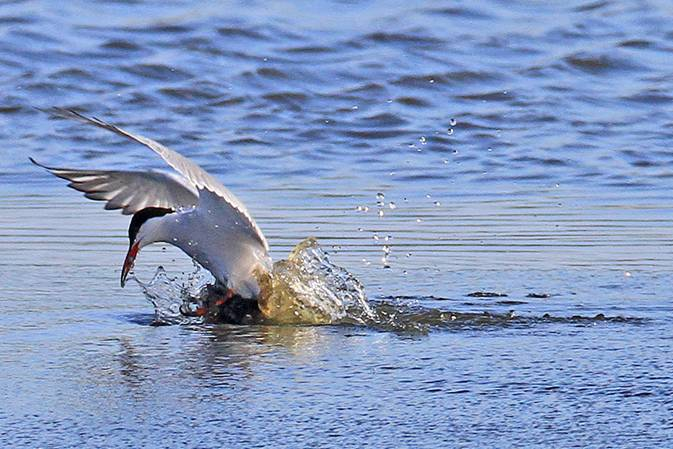
|
This Common Tern is an artist when it comes to
plunge-diving. It can hoover over a location targeting its prey
(tiny fish) and then it sweeps in, time after time, scoring a meal.
This picture is taken at one of our salinjas, the reason why we have
to conserve our salinjas. Many birds depend on the salinjas to
survive. We hope that one day soon Aruba’s salinjas will become part
of Parke Nacional Arikok. Whenever you are seeking bird action,
chances are that if you sit quietly at a salinjas you too will score
as good as this Common Tern!
Photo: Greg Peterson –
22 May 2011 – Aruba
English :
Common Tern
Papiamento :
Sternci común – of – Meuwchi piku cora
Dutch :
Visdief
Scientific :
Sterna hirundu
|
|
Courtesy:
Aruba Birdlife
Conservation
You can help save our birds!
|
|
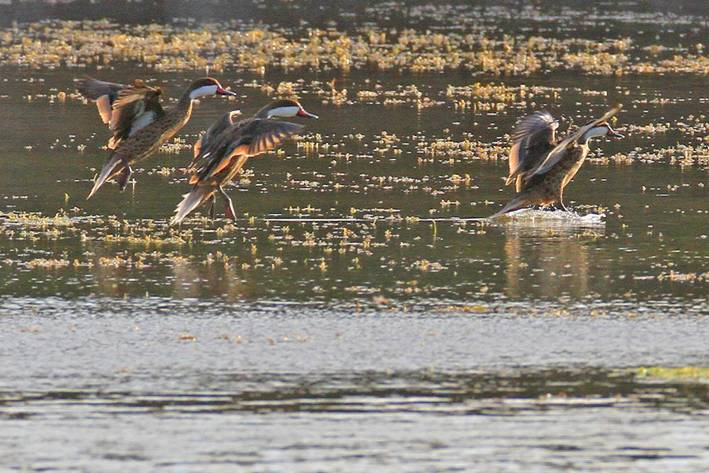
|
Bird migration is in full swing. Anywhere between 1500 and 2000
species of birds are on the move, heading North. At this moment just
a few White-cheecked Pintails are left and can be witnessed pumping
up their wing muscles in preparation for their yearly voyage. These
pintails are truly beauties and their flying skills are just
something else. But … nothing like experiencing them in a landing.
This is an early morning shot taken at a substantial distance. It
all happens in a second or two, keeping the photographer sharp. At
that time of day and with such action, hot and strong coffee is the
photographer’s best friend.
Photo: Greg Peterson – 28 May 2011 – Aruba
English : White-cheecked Pintail
Papiamento : Pato di anja
Dutch : Bahamapijlstaart
Scientific : Anas bahamensis
|
|
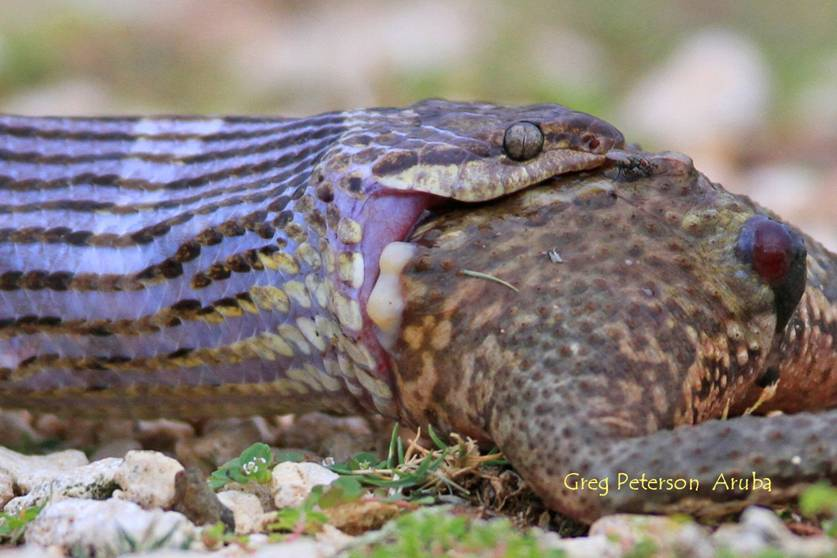
|
Aruba’s Santanero is often depicted as Aruba’s
natural pest control. This snake is basically harmless and quite
docile. It loves the more humid locations and can often be found in
gardens among plants. The ‘pest control’ nick name is due to the
prey it hunts: cockroaches and other insects, mice and as this
picture depicts, even frogs. The frog in this picture is the Sapo,
an invasive species that has a negative impact on Aruba’s fauna. So
once again the added value of our Santanero is proven. It can grow
up to 70 centimeters in length and about as broad as your thumb.
Aruba’s Santanero is an endemic subspecies and can be found nowhere
else in the world. All the more reason why our Santanero should be a
protected species in Aruba !
Photo: Greg
Peterson – 2 June 2011 – Aruba
English : Baker’s
Cat-eyed Snake
Papiamento : Santanero
Dutch : Baker’s katteoogslang
Scientific : Leptodeira annulata bakeri
|
|
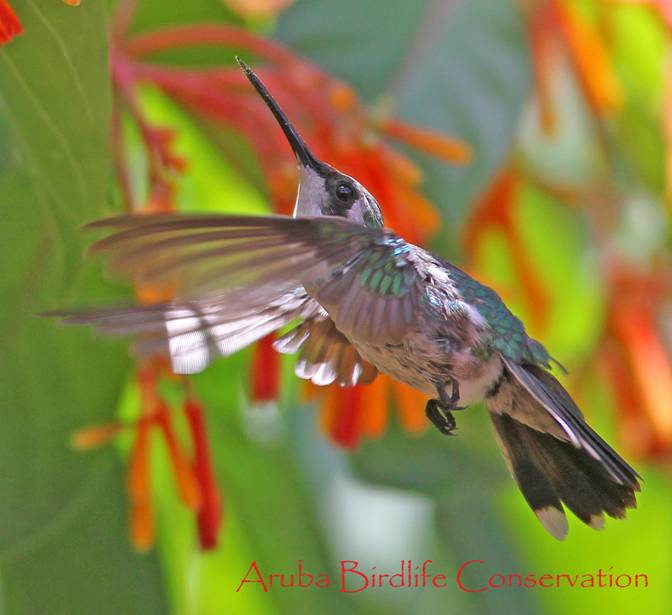
|
Beauty
in Aruba: Blue-tailed Emerald (female)
One of Aruba's jewels !!
Papiamento: Blenchi Berde
Dutch: Blauwstaartsmaragdkolibrie
Scientific: Chlorostilbon mellisigus
Photo: Greg
Peterson
|
|
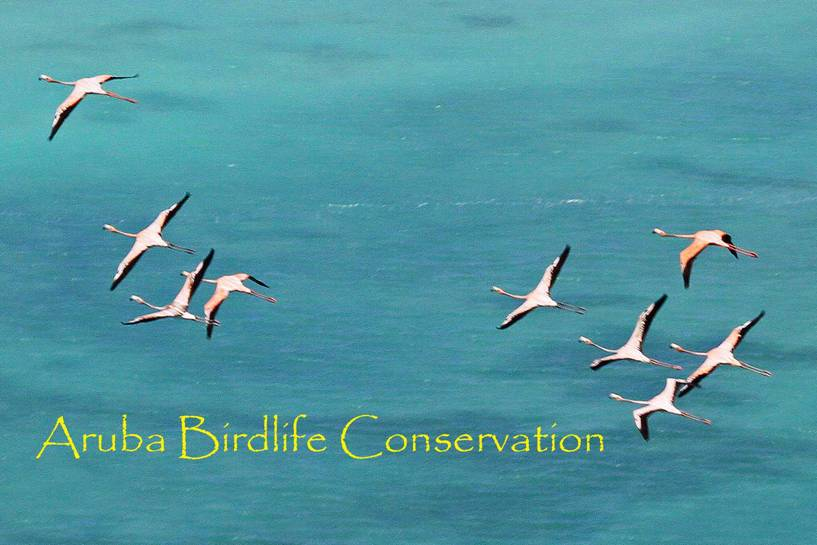
|
Flamingoes in
flight over Aruba.
Photo: Greg
Peterson
|
|
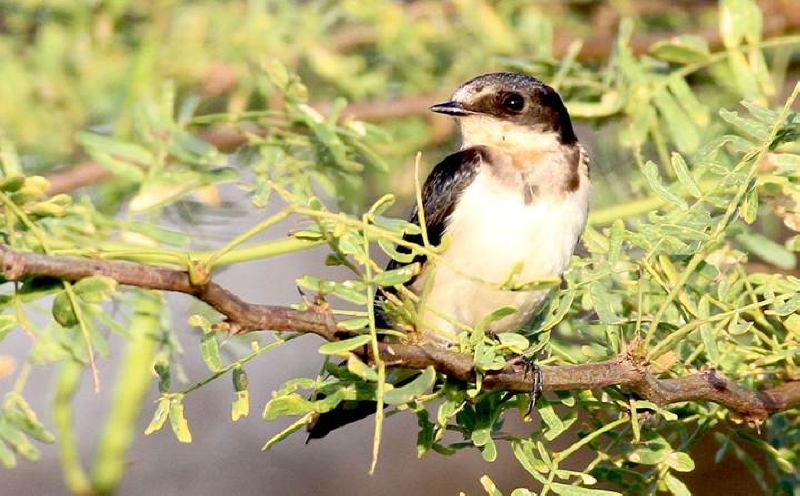
|
|
BARN SWALLOW
|
Papiamento: Swalchi
Dutch: Boerenzwaluw
Scientific: Hirundo rustica
Photo: Greg Peterson
|
|
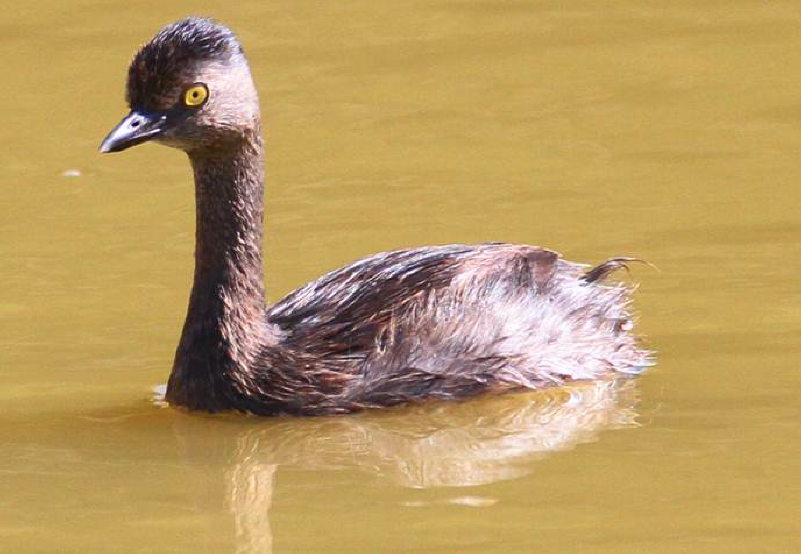
|
Papiamento: Sambuyado
chikito
Dutch: Amerikaanse Dodaars
Scientific: Tachybaptus
dominicus
Photo: Greg Peterson
|
|
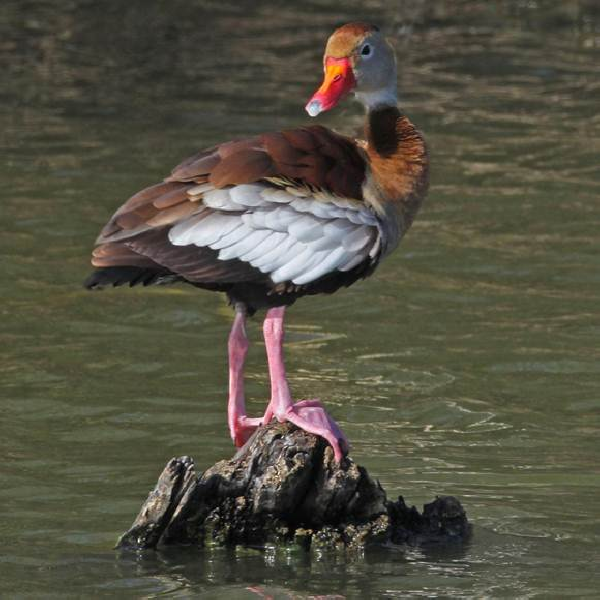
|
This Black-belied Whistling Duck is between 45 to 50 cm long. First
time recorded seen in Aruba: 10 September 1977 at Arashi. It lives
in the tropical and subtropical lowlands of North, Central and South
America, from Texas to Northern Argentina. What a beauty, this very
special guest. (Thanks to the tip I received from Andino Angela, who
in turn received the info from Lenny of Canashito Farm Supplies.
Masha danki!)
English : Black-belied Whistling Duck
Papiamento: Pato pigigi barica preto
Dutch: Zwartbuikfluiteend
Scientific: Dendrcygna autumnalis
Photo: Greg Peterson
|
|
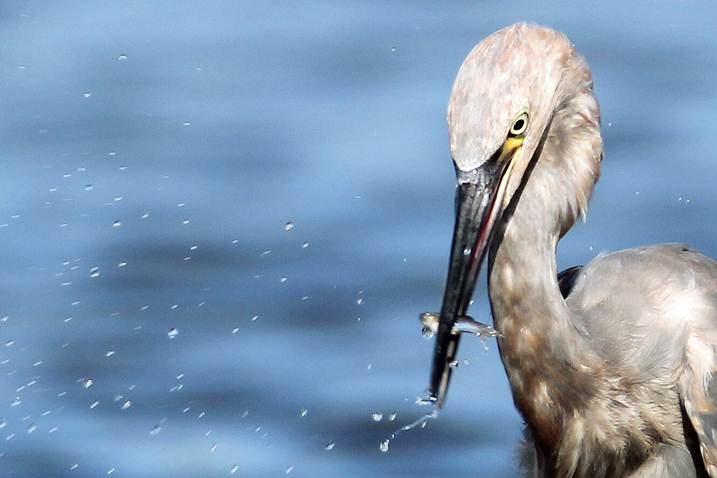
|
A
pure spectacle seeing this creature hunt for its breakfast! This
canopy feeder throws open its wings to create a shade which attracts
swiftly moving fish and then… It runs forth and back like a ballet
dancer while targeting its prey. Pure beauty in Aruba!
Photo: Greg Peterson - Aruba
Eng: Reddish Egret
Pap: Garsa cora
Ned: Roodbruine Reiger (Roodhalsreiger)
Scientific: Egreta rufuscens
|
|
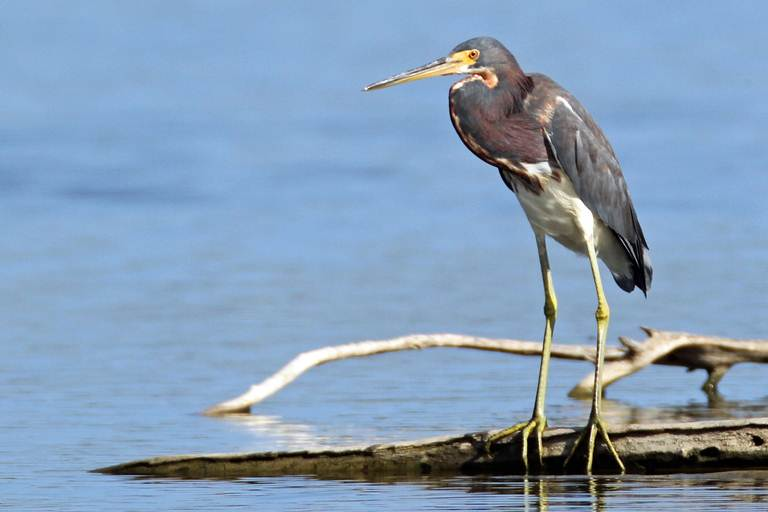
|
Warm feelings dawn upon you when you see this bird ‘do its thing’!
Pending the conditions, it adapts its hunting strategy. It will go
up to waist height in rough waters if it has to. But here in Aruba,
this is one of our repeat guests and guess what? Life in Aruba is
good for our fine feathered friend. Another expression of beauty in
Aruba!
Photo: Greg Peterson - Aruba
Eng: Tricolored Heron
Pap: Garsa barica blanco
Ned: Witbuikreiger
Scientific: Egretta tricolor
|
|
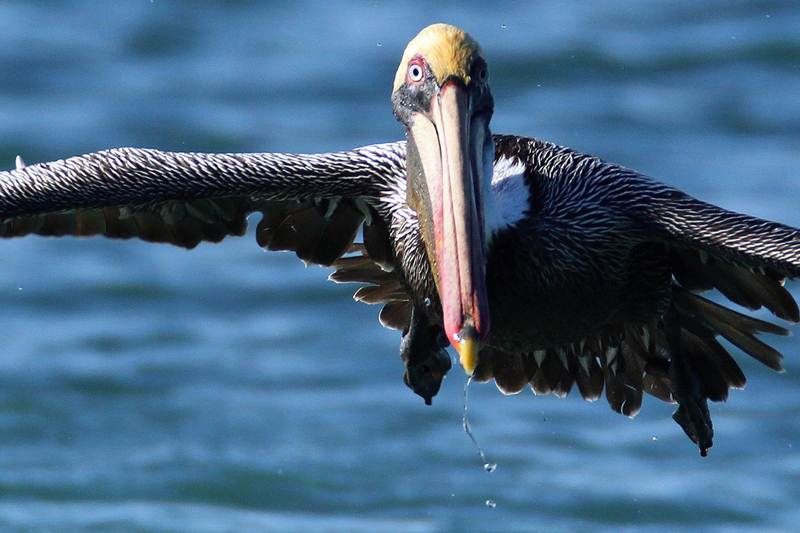
|
Our Brown Pelicans are often taken for granted. These gracious birds
can attain a length of between 100 and 135 cm, including the bill of
25 to 33 cm. These expert flyers dive into the sea repeatedly
catching fish, to take a maintenance break afterwards, often on some
type of human construction, like a pole or a fishing boat. They
carefully work over their feathers with their long beaks, stretch
their wings a couple of times ending in a whole body shake down Then
they rest for a while. These magnificent creatures breed in the
rhizophore mangroves on the reef opposite of the airport; another
reason why our reef islands should be protected.
Photo: Greg Peterson – Aruba
Eng: Brown Pelican
Pap: Pelicano or Ganshi
Ned: Bruine Pelikaan
Scientific: Pelicanus Occidentalis
|
|
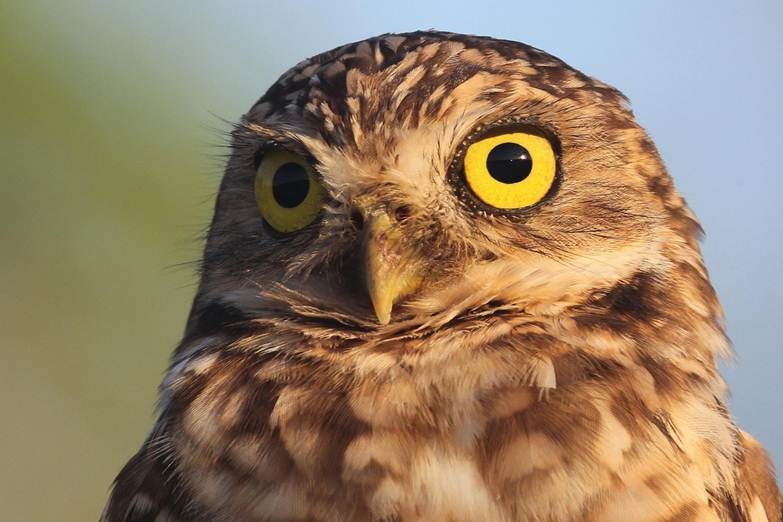
|
Aruba Birdlife Conservation started a campaign on February 4, 2011
to get our Shoco nominated as the National Bird of Aruba. Dr. Adrian
Delnevo recently estimated that there are only approximately 200
pairs of Shoco’s left. The numbers are dwindling. The Shoco is one
of the two endemic sub-species Aruba has. Protecting this unique
bird of Aruba may prevent its extinction. We hope that the
Government of Aruba will soon declare our Shoco the National Bird of
Aruba. That would be a precious gift to Aruba’s nature in
commemoration of 25 years Status Aparte. Thank you for your support!
Photo: Greg Peterson - Aruba
English: Burrowing Owl
Papiamento: Shoco
Dutch: Holenuil
Scientific: Athene cunicularia arubensis
|
|
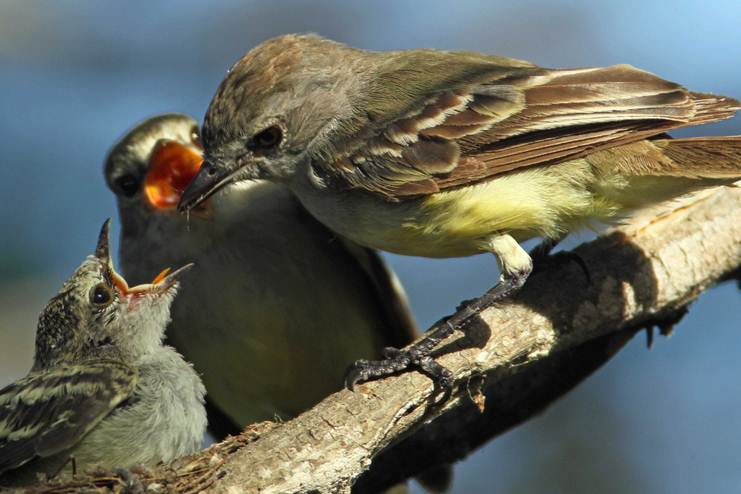
|
The Northern Scrub Flycatcher’s family is holy! They are an
emancipated species of bird. Both parents incubate and feed their
young incessantly. The clutch usually consists of 2 young. In this
case, one didn’t make it. This chick will grow strong since it is
getting double portions. It is outgrowing its 6 centimeter-nest
quickly! Whenever the three of them are together, their joy is
obvious. Here dad brings a brown ant to junior, while mom and chick
express their adorable approval.
Photo: Greg Peterson - Aruba
Engels: Northern Scrub Flycatcher
Papiamento: Parha bobo
Dutch: Noordelijke Struikvliegenpikker
Scientific: Sublegatus arenarum
|
|
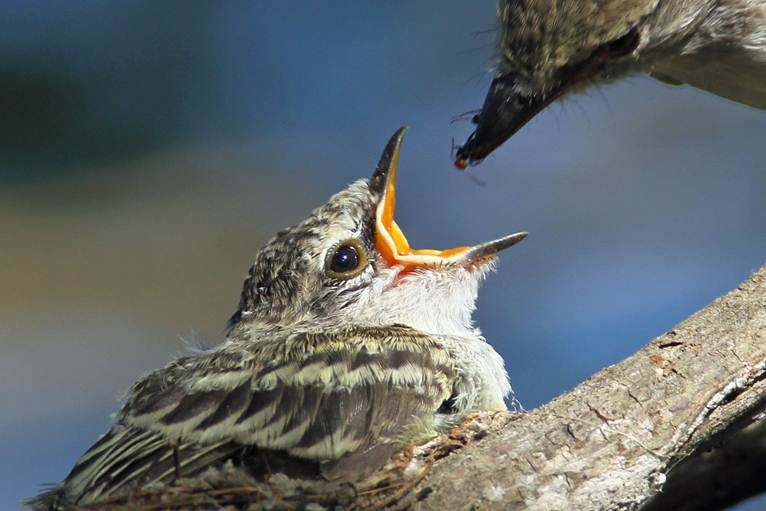
|
The Northern Scrub Flycatcher’s chick makes sure
that its parents don’t miss the spot where its food has to go. The
parents can’t miss that bright orange mouth…
Photo: Greg Peterson - Aruba
... Engels: Northern Scrub Flycatcher
Papiamento: Parha bobo
Dutch: Noordelijke Struikvliegenpikker
Scientific: Sublegatus arenarumSee More
|
|
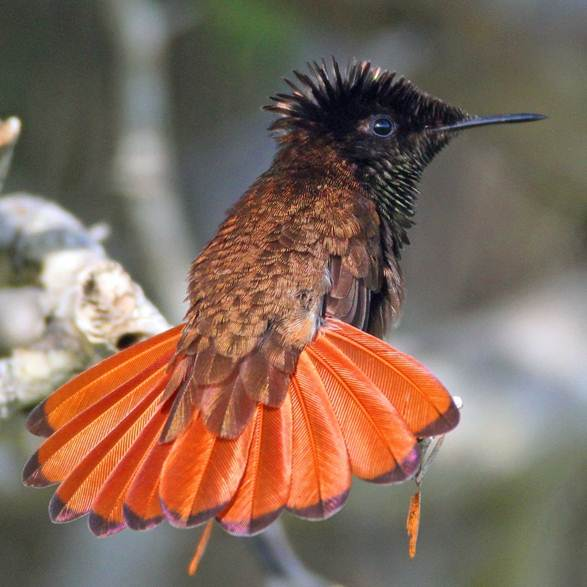 |
Our Dornasol is not only beautiful
from the front, but just as interesting and beautiful from a rear
view perspective. With the right level of sunshine, an otherwise
very dark appearing bird can really brighten up your day. The
Papiamento name ‘Dornasol’ gives true merit to its beauty; no matter
the angle. What a piece of art!
Regretfully, to date birds are not
protected in Aruba.
Photo: Greg Peterson, Sept 2011, Aruba
English : Ruby-topaz Hummingbird
Papiamento : Blenchi Dornasol
Dutch :
Rode Kolibrie
Scientific :
Chrysolampis mosquitus
|
|
Courtesy:
Aruba Birdlife
Conservation
You can help save our birds!
|
|
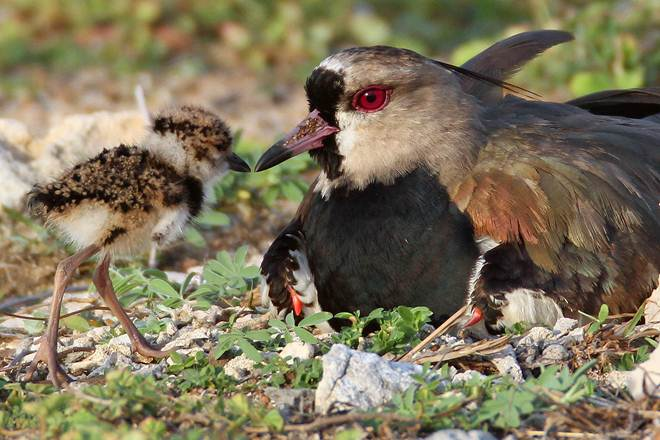 |
Once again, this
picture proves that the Southern Lapwing breeds in Aruba. Four eggs
were laid, 3 hatched, and to date it seems that 2 have survived.
Their biggest threat at this point of their lives: off-road quad
racing. I am keeping my fingers crossed.
Regretfully, to
date birds are not protected in Aruba.
Photo: Greg
Peterson – Sept 2011 – Aruba
English : Southern
Lapwing
Papiamento : Kivit
sur-amerikano
Dutch : Chileense
Kievit
Scientific :
Vanellus chilensis
|
|
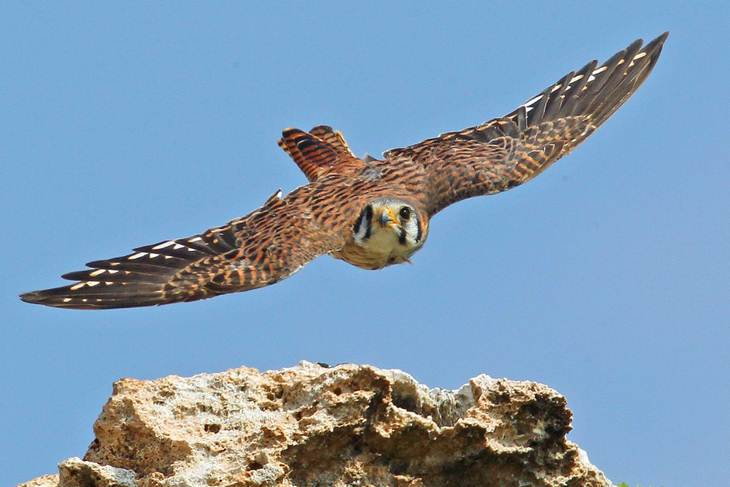 |
A pair of American Kestrels was flirting
on the edges of our cliffs. For a moment, it looked like they were
even trying to impress one another with their aeronautical skills.
The updraft of the wind at the cliff’s edges is one of their
favorite playing grounds. They dance with Aruba’s warm breeze!
Birds are still not protected in Aruba.
You can help make a difference! Try convincing your favorite
Ministers and/or Members of Parliament to help get our birds
protected. Thank you for caring!
Photo: Greg Peterson – 1 October2011 – San Nicolas - Aruba
English : American Kestrel
Papiamento : Kinikini
Dutch : Amerikaanse Torenvalk
Scientific : Falco sparverius
|
|
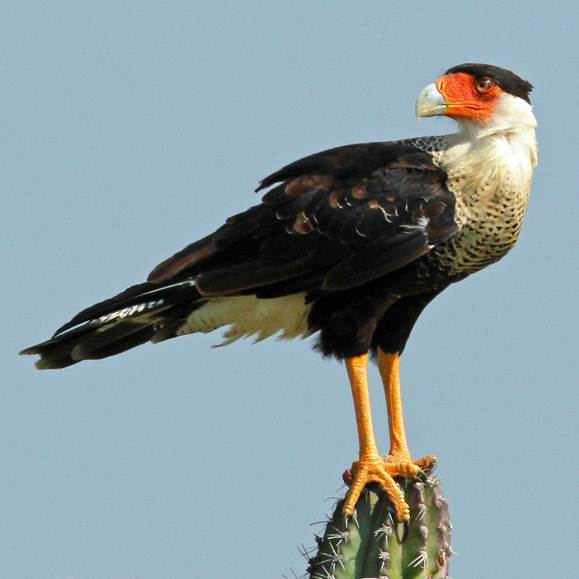 |
The Caracara Cheriway, known by our
locals as the ‘Warawara’, wears a beautiful orange mask. To its rear
protrude its binoculars: 20-20 vision! Resting on the top of our
cacti is also a great opportunity to detect a potential dinner. They
are not only great flyers. They master the art of running as well
and they do so faster than our lizards can!
Birds are still not protected in Aruba.
You can help make a difference! Try convincing your favorite
Minister or Members of Parliament to help get our birds protected.
Thank you for caring!
Photo: Greg Peterson – 28 December 2010
– Aruba
English : Crested Caracara
Papiamento : Warawara
Dutch : Kuifcaracara
Scientific : Caracara
Cheriway
|
|
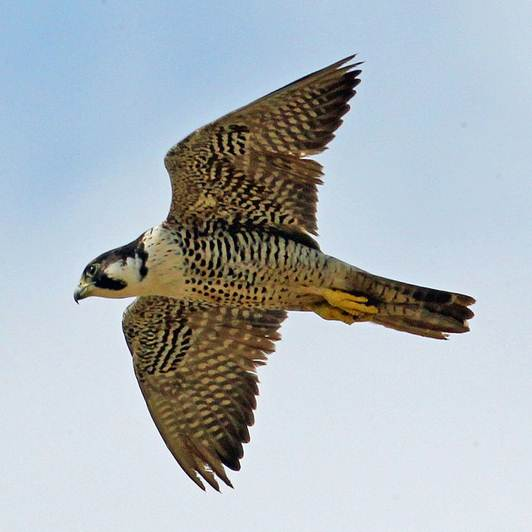 |
The Peregrine Falcon has returned for
his winter stay over in Aruba. Today I spotted 2. Mr. Bill Mattox,
an expert on Peregrine Falcons explained to me how proof was
collected that the bird can fly to Aruba all the way from Greenland.
This is the master of the skies. Birds …
beware!
Birds are still not protected in Aruba.
You can help make a difference! Try convincing your favorite
Minister or Members of Parliament to help get our birds protected.
Thank you for caring!
Photo: Greg Peterson – 1 October 2011 –
San Nicolas - Aruba
English: Peregrine Falcon
Papiamento : Falki
Peregrino
Dutch: Slechtvalk
Scientific: Falco peregrinus
|
|
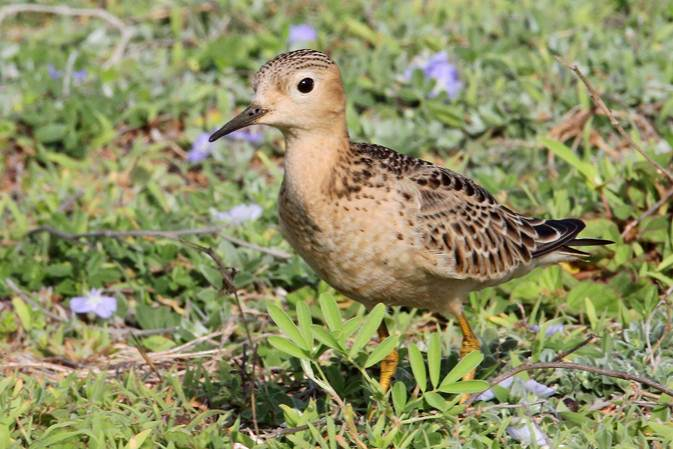 |
The Buff-breasted Sandpiper is unique among North
American shorebirds in having a lek mating system. Males defend
relatively small territories that provide no resources for females and
are simply display sites to which females can be attracted. Females
select a mate and then leave to nest and raise their chicks elsewhere.
Breeds in dry, grassy tundra. On migration and in winter found in dry
grasslands (usually short grass), pastures, plowed fields and, rarely,
mudflats.
Info from: The Cornell Lab of Ornithology
Birds are still not protected in Aruba. You can help make a difference!
Try convincing your favorite Ministers and/or Members of Parliament to
help get our birds protected. Thank you for caring!
Photo: Greg Peterson – 2 October2011 – San Nicolas - Aruba
English : Buff-breasted Sandpiper
Papiamento : Snepi blond boca chikito
Dutch : Blonde Ruiter
Scientific : Tryngites subruficollis
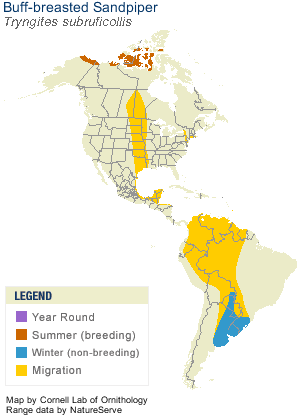 |
|
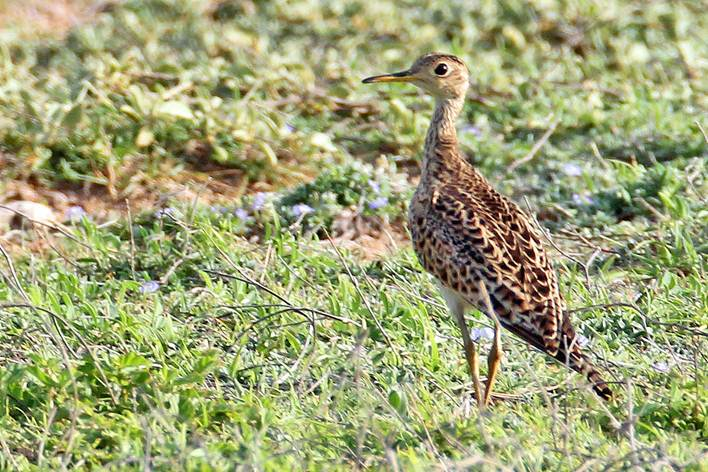 |
A shorebird of grasslands, not shores, the Upland
Sandpiper inhabits native prairie and other open grassy areas in North
America. Once abundant in the Great Plains, it has undergone steady
population declines since the mid-19th century, because of hunting and
loss of habitat.
Info from: The Cornell Lab of Ornithology
Birds are still not protected in Aruba. You can help make a difference!
Try convincing your favorite Ministers and/or Members of Parliament to
help get our birds protected. Thank you for caring!
Photo: Greg Peterson – 2 October2011 – San Nicolas - Aruba
English : Upland Sandpiper
Papiamento : Snepi Bartram
Dutch : Bartrams Ruiter
Scientific : Bartramia longicauda
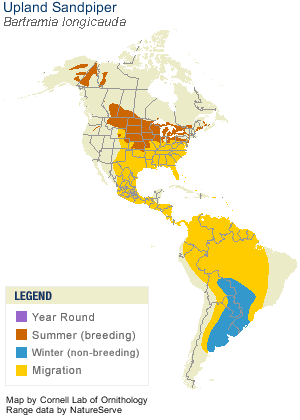 |
|
Greg Peterson sent in some unique
footage of a parent Crested Caracara or ‘Warawara’ as it is
known by our locals, feeding its chick.
This short film footage was made on
Sunday, 16 October 2011, in Aruba.
It is dedicated to Her Majesty Queen
Beatrix, Queen of The Kingdom of The Netherlands.
Our Queen will visit Aruba shortly and
Aruba Birdlife Conservation welcomes her wholeheartedly by means of
this tribute.
The members of the Royal Family are
nature lovers!
Very few people have ever seen such a
feeding event, so please share it with all of your contacts and
please show it to the children!
CLICK ON THE NEXT
LINE TO SEE THE FOOTAGE ON YOU TUBE
Aruba's Majestic Crested
Caracara
|
|
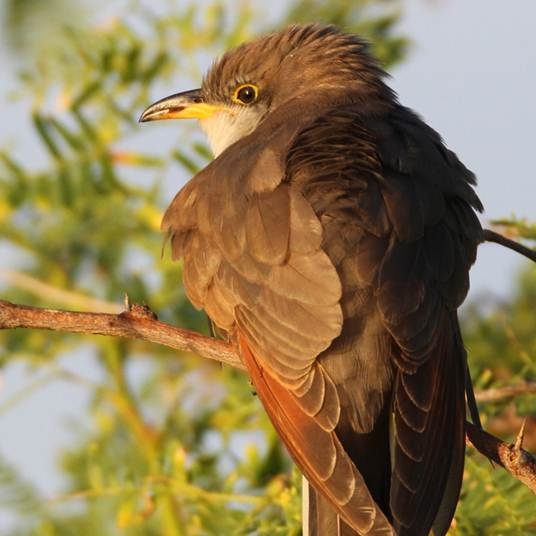 |
During the last three weeks I received quite some
feedback from bird lovers that they have spotted this bird in Aruba. I
have seen five myself in one area. Most of them are spotted sitting
quietly somewhere. That is because they are exhausted from their journey
to their southern destinations. They breed from central California,
Minnesota, and southern New Brunswick southward. Once winter approaches
they travel to South America and may fly all the way to northern
Argentina.
Some stopover in Aruba for a little rest and some insects before they
continue southwards. When the early morning sunshine caresses their
feathers, they really look so beautiful!
English : Yellow-billed Cuckoo
Papiamento : Cucu pico hel
Dutch : Geelsnavelkoekoek
Scientific : Coccyzus americanus
Photo: Greg Peterson – 23 October 2011 – Aruba
Aruba Birdlife Conservation |
|
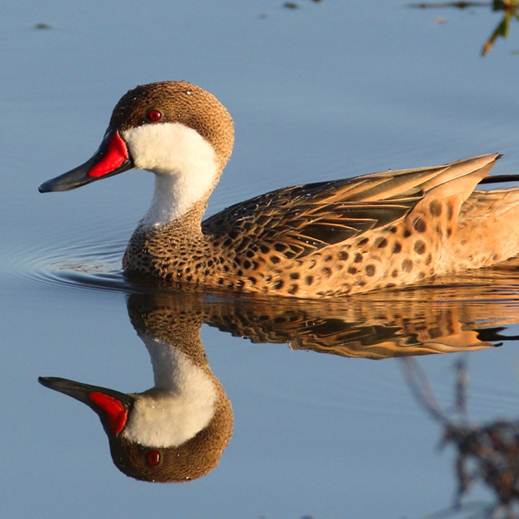 |
During our rainy season, every now and then our loyal
north-eastern trade winds take a rest, albeit for maybe just a day. Such
calmness can turn otherwise rimpled waters into a mirror. This migrant
White-cheecked Pintail was obviously enjoying the peacefulness of the
day!
English : White-cheecked Pintail
Papiamento : Pato di anja
Dutch : Bahamapijlstaart
Scientific : Anas bahamensis
Photo: Greg Peterson – 23 October 2011 – Aruba
Aruba Birdlife Conservation |
|
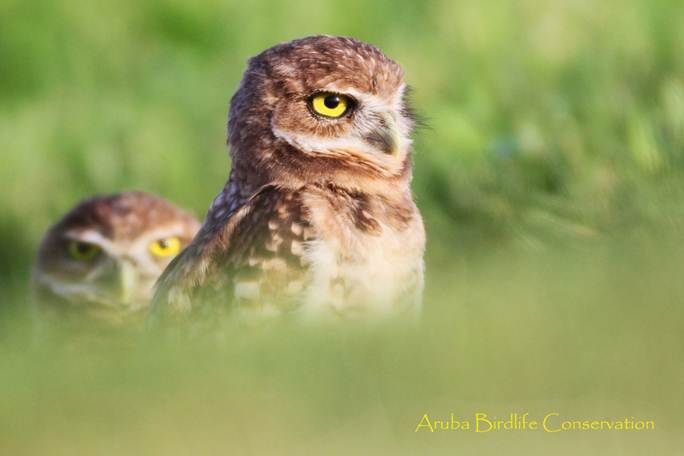 |
It has recently been estimated that
there are approximately only some 200 pairs of our Shoco left,
Aruba’s Burrowing Owl; more the reason why it is a real treat to
witness Shoco offspring. Aruba Birdlife Conservation hopes that the
Government of Aruba will soon declare the Shoco the National Bird of
Aruba. In such the Government will then give this magnificent
creature a better chance of not going extinct and thus preserving it
for future generations. We keep our hopes high!
English : Burrowing owl
Papiamento : Shoco
Dutch : Holenuil
Scientific : Athene
cunicularia arubensis
Photo: Greg Peterson – 23 October 2011
– Aruba
Aruba Birdlife Conservation
|
|
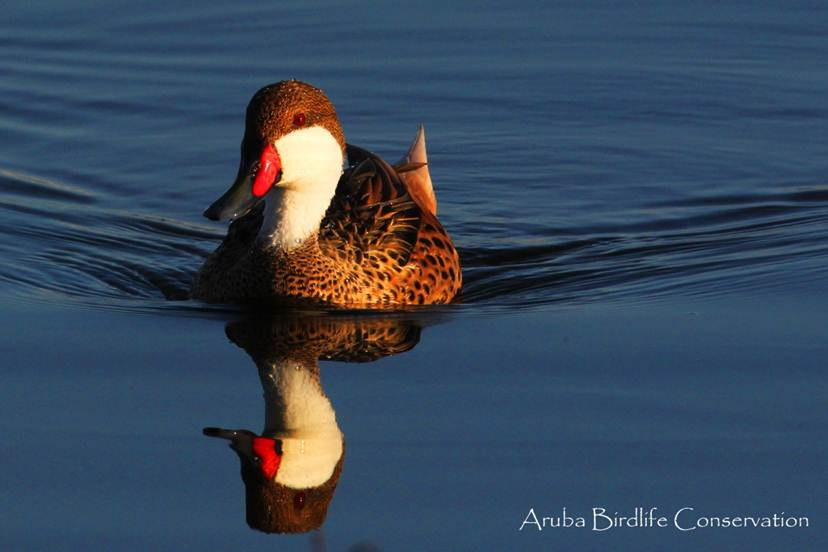 |
The White-cheeked
Pintail can depict gracefulness of Aruba’s nature beyond aw.
English :
White-cheeked Pintail
Papiamento : Pato di anja
Dutch :
Bahamapijlstaart
Scientific : Anas bahamensis
Photo: Greg
Peterson – 23 October 2011 – Aruba
Aruba Birdlife
Conservation
|
|
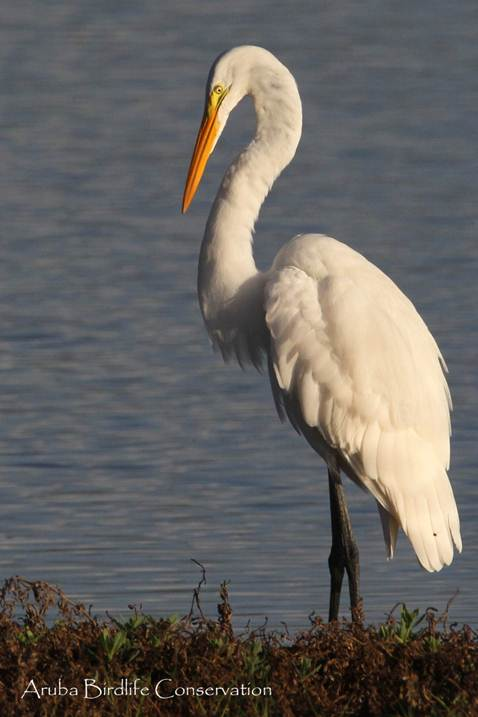 |
Elegantly peaceful…
English: Great Egret
Papiamento: Garsa blanco grandi
Dutch: Grote Zilverreiger
Scientific: Ardea alba
Photo: Greg Peterson, 23 October 2011,
Aruba
Aruba Birdlife Conservation
|
|
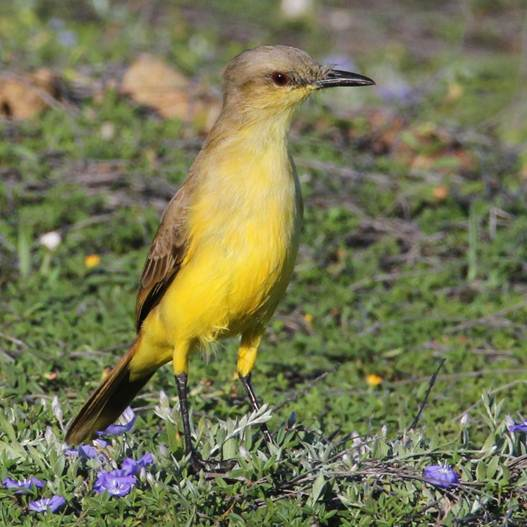 |
To identify this
bird, I turned to the expert Adrian Delnevo (my bird ‘guru’). This
is what Adrian thought and told me today:
“Basically, it
is a ground foraging fly-catcher, somewhat similar to a tropical
kingbird (fly-catcher), but largely more terrestrial in its foraging
and behavior. In South America, particularly Venezuela – where it is
common, it is often associated with cattle or other animals, and can
be seen ‘perching’ on their back while looking for disturbed
insects.”
Adrian was only
aware of one other record for this species in the ABC islands. This
occurred on Aruba, at Savaneta between April 5, 2002 to early June
2003 (T.G. Prins et al. 2009. Checklist of the Birds of Aruba,
Curacao, and Bonaire).
Thank you Adrian.
For the record. Two were spotted this morning at about 7:30 a.m.
English: Cattle
Tyrant
Papiamento: Pimpiri
vakero
Dutch: Veetiran
Scientific:
Machetornis rixosa
Photo: Greg
Peterson, 29 October 2011, Aruba
Aruba Birdlife
Conservation
|
|
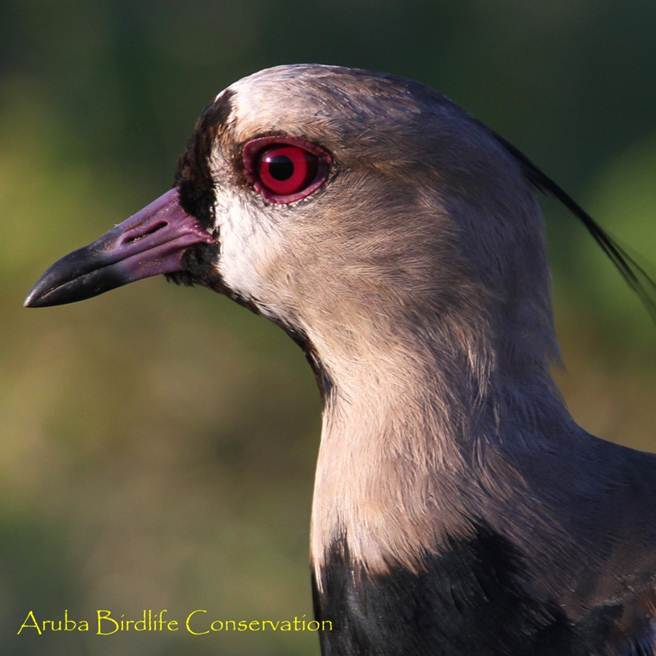 |
Just like our
Princes Maxima, the Southern Lapwing can come from as far as
Argentina!
Majestic beauty!
English : Southern Lapwing
Papiamento : Kivit sur-amerikano
Dutch : Chileense Kievit
Scientific : Vanellus chilensis
Photo: Greg Peterson – 29 October
2011 – Aruba
Aruba Birdlife
Conservation
|
|
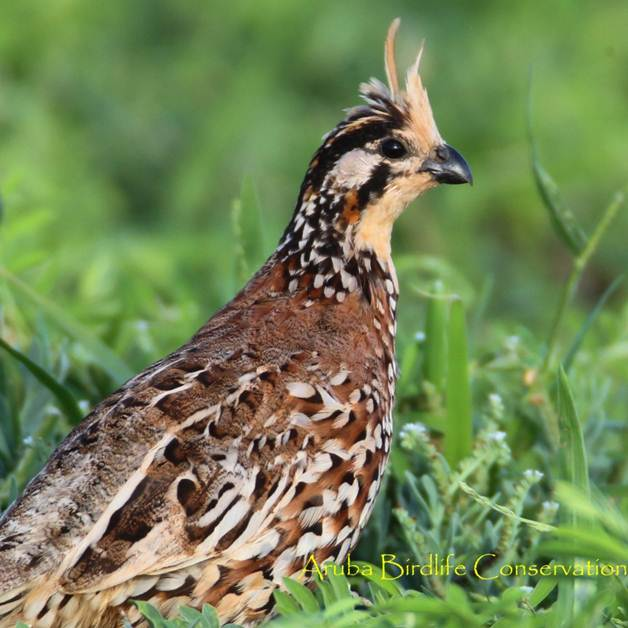 |
Normally the
Patrishi is difficult to see. They are masters of camouflage. Now
that their habitat is diminishing and the invasive Boa constrictor
is patiently waiting on them in the underbrush, they have become
very scarce. The time has come for us to protect them.
English : Crested
Bobwhite
Papiamento :
Patrishi
Dutch :
Kuifbobwhite
Scientific : Colinus cristatus
Photo: Greg Peterson – 29 October
2011 – Aruba
Aruba Birdlife
Conservation
|
|
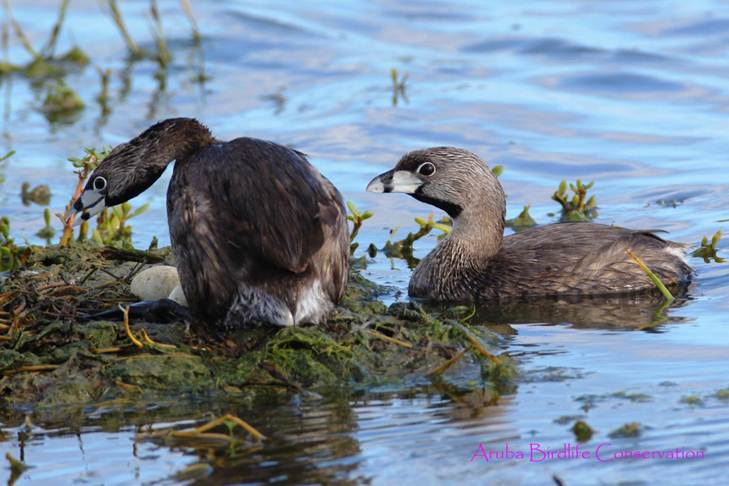 |
Two
species of Grebes can be found in Aruba: the Pied-billed Grebe and
the Least Grebe.
Here we see the Pied-billed Grebes with
their newly laid two eggs. Yes, they breed in Aruba. What a ‘Grebish
Delight’!
English: Pied-billed Grebe
Papiamento: Sambuyado pico diki
Dutch: Dikbekfuut
Scientific: Podilymbus podiceps
Photo: Greg Peterson
– 29 October 2011 – Aruba
Aruba
Birdlife Conservation
|
|
Aruba’s Southern Lapwing
This is a short
film on Aruba's Southern Lapwing shot by Greg Peterson with the
Aruba Birdlife Conservation.
|
|
Courtesy:
Aruba Birdlife
Conservation
You can help save our birds!
|
|
“What it takes to
raise a chick” … is a short film of the Northern Scrub Flycatcher
(Papiamento: Parha bobo) raising its young, filmed in Aruba!
|
|
|
|
Love is in the air!
A pair of Kinikinis getting ready to
mate.
American Kestrel – Amerikaanse Torenvalk
– Falco sparverius
Photo: Greg Peterson
Aruba Birdlife Conservation
|
|
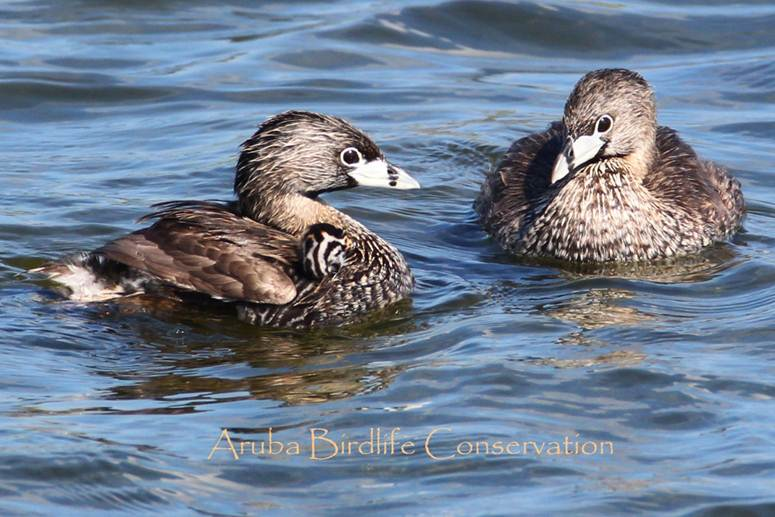 |
There are 3 Pied-billed
Grebes in this picture.
Take your
time and try to discover the new born chic!
Born in
Aruba!
Pap: Sambuyado pico diki
Ned:
Dikbekfuut
Sc:
Podilymbus podiceps
Photo: Greg Peterson
Aruba Birdlife
Conservation
|
|
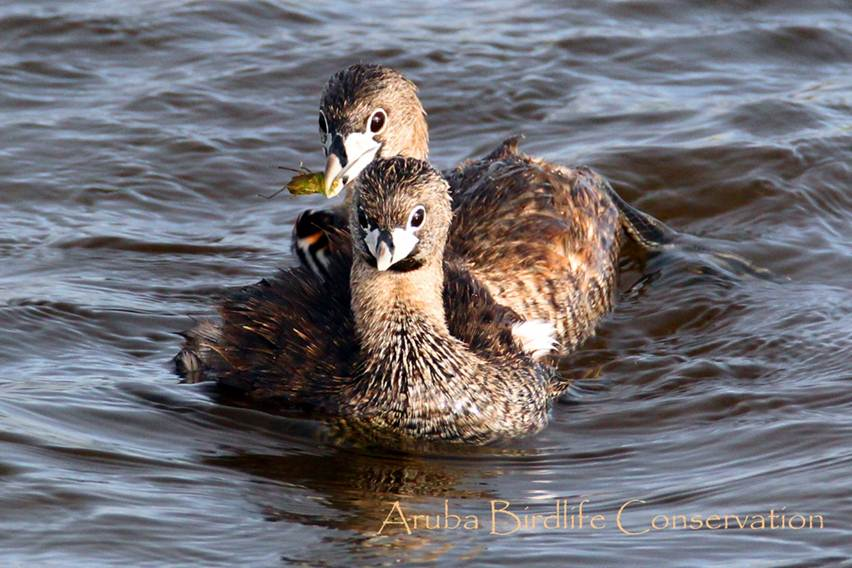 |
One parent gives the
offspring shelter on its back while the other feeds it!
Humans can learn a lot from birds!
Sambuyado pico diki - Dikbekfuut -
Podilymbus podiceps
Photo: Greg Peterson
Aruba Birdlife Conservation
|
|
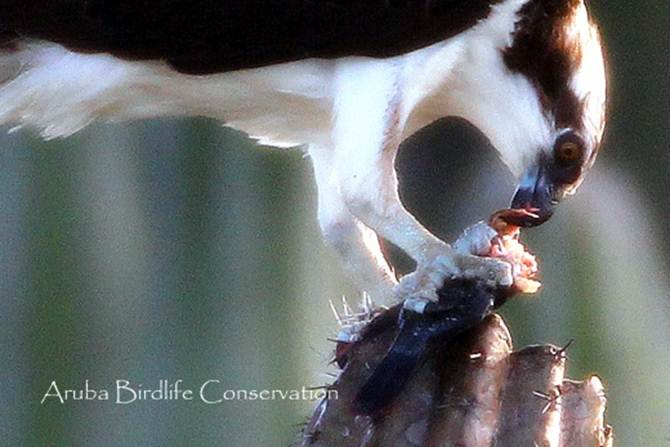 |
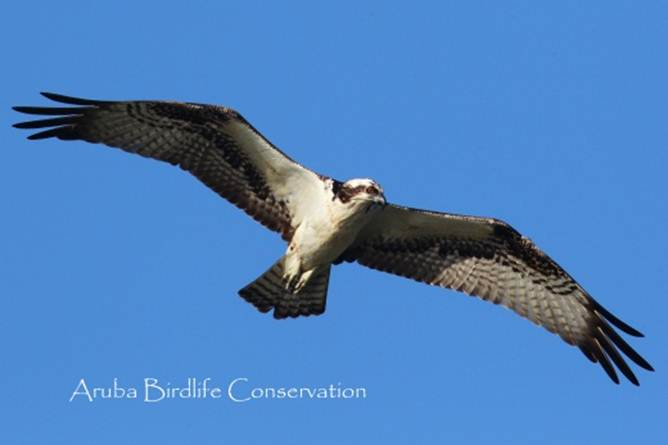 |
The majestic Osprey
having its fill after a successful hunt on Christmas day. One of the
marvelous birds that visit Aruba every year. A spectacle to see…
English: Osprey
Papiamento: Gabilan
Piscador
Dutch: Visarend
Scientific: Pandion
haliaetus
Photos at Tierra
del Sol by Greg Peterson
Aruba Birdlife
Conservation
|
|
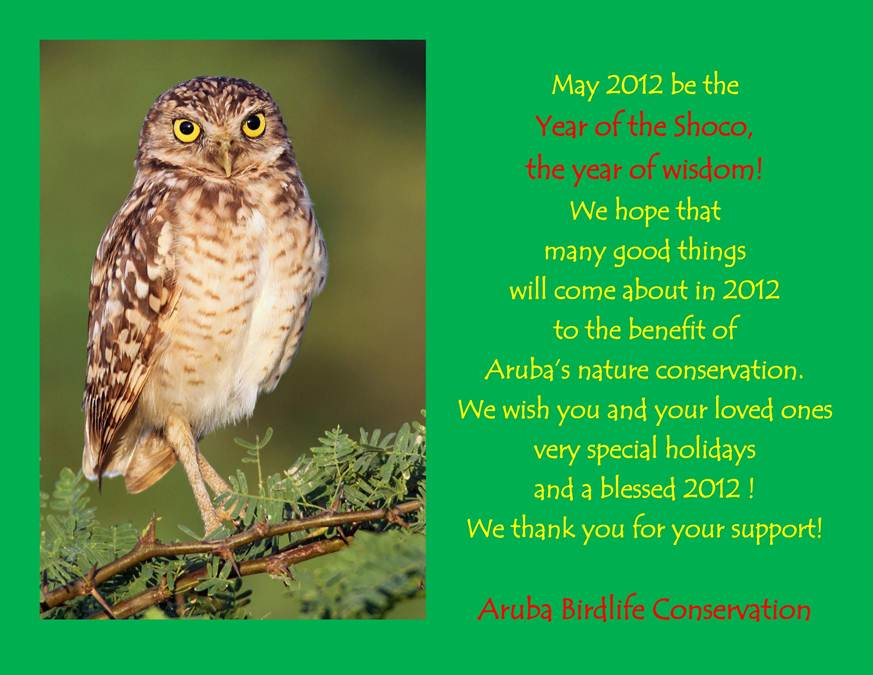 |
|
CLICK HERE TO SEE GREG'S ORIGINAL PLEA FOR SUPPORT.
|
|
CLICK HERE TO SEE GREG'S SECOND
PLEA FOR HELP ON THIS MATTER
|
|
CLICK HERE TO RETURN TO THE ARUBA BIRDLIFE CONSERVATION
DIRECTORY
|
|
CLICK HERE TO SEE
GREG'S PHOTOS OF BIRDS AND WILDLIFE IN ARUBA TAKEN IN 2012 |
